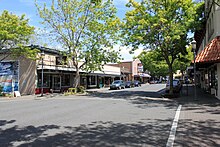Edmonds, Washington
Edmonds is a regional hub for the arts, with museums, specialized facilities, and major annual festivals within the city's downtown area.Prior to the 19th century, the Edmonds area was inhabited by the Suquamish tribe, who foraged and fished near the flat beach forming modern-day downtown.[7] A 147-acre (59 ha) land claim for the area was filed by Pleasant Ewell in 1866 and was sold to various landowners before being eventually purchased by Canadian-born logger George Brackett in 1872 for $650.Brackett had allegedly found the future site of Edmonds in 1870 while searching for potential logging areas on his canoe, which was blown ashore during a storm.To meet the minimum population of 300 residents required for incorporation, a popular legend states that Brackett added the names of his two oxen to the census conducted prior to the election.[12] The same year, Edmonds was selected as a stop on the Seattle and Montana Railroad (later absorbed into the Great Northern Railway), sparking interest from real estate investors.[27] During the Great Depression, all but two mills continued to operate and were supplemented by local improvement projects organized by the federal Works Progress Administration, including regraded streets, new parks, and the addition of an auditorium and sportsfields to the high school.[7][34] Despite population growth, Edmonds restricted the construction of multi-family dwellings in an effort to keep the downtown area and older neighborhoods "rural-like" and low density.[35][38] The "Main Street Project", funded by local businesses, restored empty storefronts and attracted restaurants to the city in the late 1980s, fueling a downtown revival.[31][43] The Point Edwards oil terminal on the city's waterfront was closed by Unocal in 1991 and the 53-acre (21 ha) site was sought by Edmonds and Snohomish County for redevelopment.[46] The sewage treatment plant was opposed by the city government and citizen groups, and was ultimately moved to an alternative site near Woodinville in 2003.The unincorporated area of Esperance, located in the southeast corner of the city, is an enclave of Edmonds and has resisted several attempts at annexation.[55] The Puget Sound makes up 86 percent of the city's drainage basin, with other streams flowing into Lake Ballinger to the southeast.[56] The city's main commercial districts are Downtown Edmonds, situated in a valley known as the "bowl", and the State Route 99 corridor at its east end.[58][59] The city has several outlying suburban neighborhood with their own commercial centers, including Firdale, Five Corners, Perrinville, Seaview, Sherwood, and Westgate.The city's largest employers are the Edmonds School District, Swedish Medical Center, and large retailers, which includes grocery stores and car dealerships.[79][80] The municipal government employs 224 people full-time and operates on an annual budget of $98 million that is mostly funded by property and retail sales taxes.[81] The budget funds the city's various departments, which includes parks and recreation, public works, water utilities, the municipal court, and emergency services.The festival is one of the largest in the Pacific Northwest, attracting 75,000 visitors, and has 200 participating artists with booths along Main Street and at the Frances Anderson Center.[108] Edmonds is home to a weekly farmers' market that runs from June to October on Saturdays and is sponsored by the Edmonds–South Snohomish County Historical Society.[118][119] The city government built a new library in 1982 that features 20,000 square feet (1,900 m2) of space and an outdoor plaza overlooking Puget Sound.[123] A temporary location at an adjacent city building opened the following month with most services and limited materials while the original library was repaired and renovated.[127] A small 9/11 memorial, including a steel beam from the World Trade Center, is located at a fire station near downtown Edmonds and was dedicated in 2015.[71][129] Edmonds Stadium, which was home to high school sports and minor league football and soccer teams (including the North Sound SeaWolves), was opened in 1937 and closed in 2017.[134][135] The city also has several urban forests and natural reserves, which preserve the original vegetation of the area and provide hiking and walking trails.[192] Edmonds is served by several modes of transportation that converge in the downtown area, including roads, railroads, ferries, and buses.It also operates the Swift Blue Line on State Route 99, a bus rapid transit service connecting Aurora Village and Everett.[194] Until 2024, Community Transit operated direct express buses to from park and ride lots in Edmonds to Downtown Seattle and the University District.[194] They were replaced by the Link light rail extension to Lynnwood and a new express bus that connects Downtown Edmonds to Mountlake Terrace station.[204][205] Disposal of garbage, recycling, and yard waste is contracted by the city government to three private companies serving different areas of Edmonds.








Washington State FerriesWashingtonCountySnohomishIncorporatedMayor–councilTime zonePacific (PST)Area codeFIPS codeSnohomish County, WashingtonPuget SoundOlympic MountainsSeattle metropolitan areaSeattleEverett2020 U.S. censusGreat Northern Railwayshinglebedroom communitiesstate highwaysstate ferry systemferry routeKingstonKitsap Peninsuladowntown train stationAmtrakSounder commuter trainsCommunity TransitSuquamishCharles WilkesBallardplattedpost officeGeorge Franklin EdmundsSeattle and Montana RailroadPanic of 1893forecloseLake Ballingeriron foundryinterurban lineMosquito fleetLynnwoodstagecoachKingston ferryPuget Sound Navigation CompanyUnion Oil Companyoil terminalGreat DepressionWorks Progress Administrationhigh schoolroof shinglesaluminumasphaltbreakwatermarinaannexedState Route 99multi-family dwellingscommunity collegefishing pierKing Countymultimodal transportationcommuter railsewage treatmentsewage treatment plantWoodinvilleWestern WashingtonWoodwayShorelineMountlake TerraceInterurban TrailEsperanceenclaveUnited States Census Bureaudrainage basinPerrinvilleworkforcecarpooledpublic transitAlderwoodAurora Villageservices sectorEdmonds School DistrictSwedish Medical Centersales taxMarysville2010 U.S. censusannexationsKoreansU.S. Census Bureauper capita incomeranking 20thpoverty line2010 censuspopulation densityracial makeup2000 censuscode citymayor–council governmentnonpartisanat-largepropertyretail salesparks and recreationpublic worksmunicipal courtfire department2nd congressional district7th congressional districtSnohomish County CouncilgalleriesEdmonds Arts FestivalFather's DayCascadia Art MuseumMemorial Daycreative districtfountainroundaboutdrunk drivergazebofarmers' marketgarden festivalfood festivalThe EnterpriseThe Everett Herald